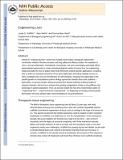| dc.contributor.author | Griffith, Linda G. | |
| dc.contributor.author | Wells, Alan | |
| dc.contributor.author | Stolz, Donna B. | |
| dc.date.accessioned | 2015-10-21T12:00:45Z | |
| dc.date.available | 2015-10-21T12:00:45Z | |
| dc.date.issued | 2014-05 | |
| dc.date.submitted | 2013-05 | |
| dc.identifier.issn | 02709139 | |
| dc.identifier.issn | 1527-3350 | |
| dc.identifier.uri | http://hdl.handle.net/1721.1/99381 | |
| dc.description.abstract | Interest in “engineering liver” arises from multiple communities: therapeutic replacement; mechanistic models of human processes; and drug safety and efficacy studies. An explosion of micro- and nanofabrication, biomaterials, microfluidic, and other technologies potentially affords unprecedented opportunity to create microphysiological models of the human liver, but engineering design principles for how to deploy these tools effectively toward specific applications, including how to define the essential constraints of any given application (available sources of cells, acceptable cost, and user-friendliness), are still emerging. Arguably less appreciated is the parallel growth in computational systems biology approaches toward these same problems—particularly in parsing complex disease processes from clinical material, building models of response networks, and in how to interpret the growing compendium of data on drug efficacy and toxicology in patient populations. Here, we provide insight into how the complementary paths of engineering liver—experimental and computational—are beginning to interplay toward greater illumination of human disease states and technologies for drug development. | en_US |
| dc.description.sponsorship | National Institutes of Health (U.S.) (UH2TR000496) | en_US |
| dc.description.sponsorship | National Institutes of Health (U.S.) (R01-EB 010246) | en_US |
| dc.description.sponsorship | National Institutes of Health (U.S.) (R01-ES015241) | en_US |
| dc.description.sponsorship | National Institutes of Health (U.S.) (P30-ES002109) | en_US |
| dc.language.iso | en_US | |
| dc.publisher | Wiley Blackwell | en_US |
| dc.relation.isversionof | http://dx.doi.org/10.1002/hep.27150 | en_US |
| dc.rights | Creative Commons Attribution-Noncommercial-Share Alike | en_US |
| dc.rights.uri | http://creativecommons.org/licenses/by-nc-sa/4.0/ | en_US |
| dc.source | PMC | en_US |
| dc.title | Engineering liver | en_US |
| dc.type | Article | en_US |
| dc.identifier.citation | Griffith, Linda G., Alan Wells, and Donna B. Stolz. “Engineering Liver.” Hepatology 60, no. 4 (May 19, 2014): 1426–1434. | en_US |
| dc.contributor.department | Massachusetts Institute of Technology. Department of Biological Engineering | en_US |
| dc.contributor.mitauthor | Griffith, Linda G. | en_US |
| dc.relation.journal | Hepatology | en_US |
| dc.eprint.version | Author's final manuscript | en_US |
| dc.type.uri | http://purl.org/eprint/type/JournalArticle | en_US |
| eprint.status | http://purl.org/eprint/status/PeerReviewed | en_US |
| dspace.orderedauthors | Griffith, Linda G.; Wells, Alan; Stolz, Donna B. | en_US |
| dc.identifier.orcid | https://orcid.org/0000-0002-1801-5548 | |
| mit.license | OPEN_ACCESS_POLICY | en_US |
| mit.metadata.status | Complete | |
